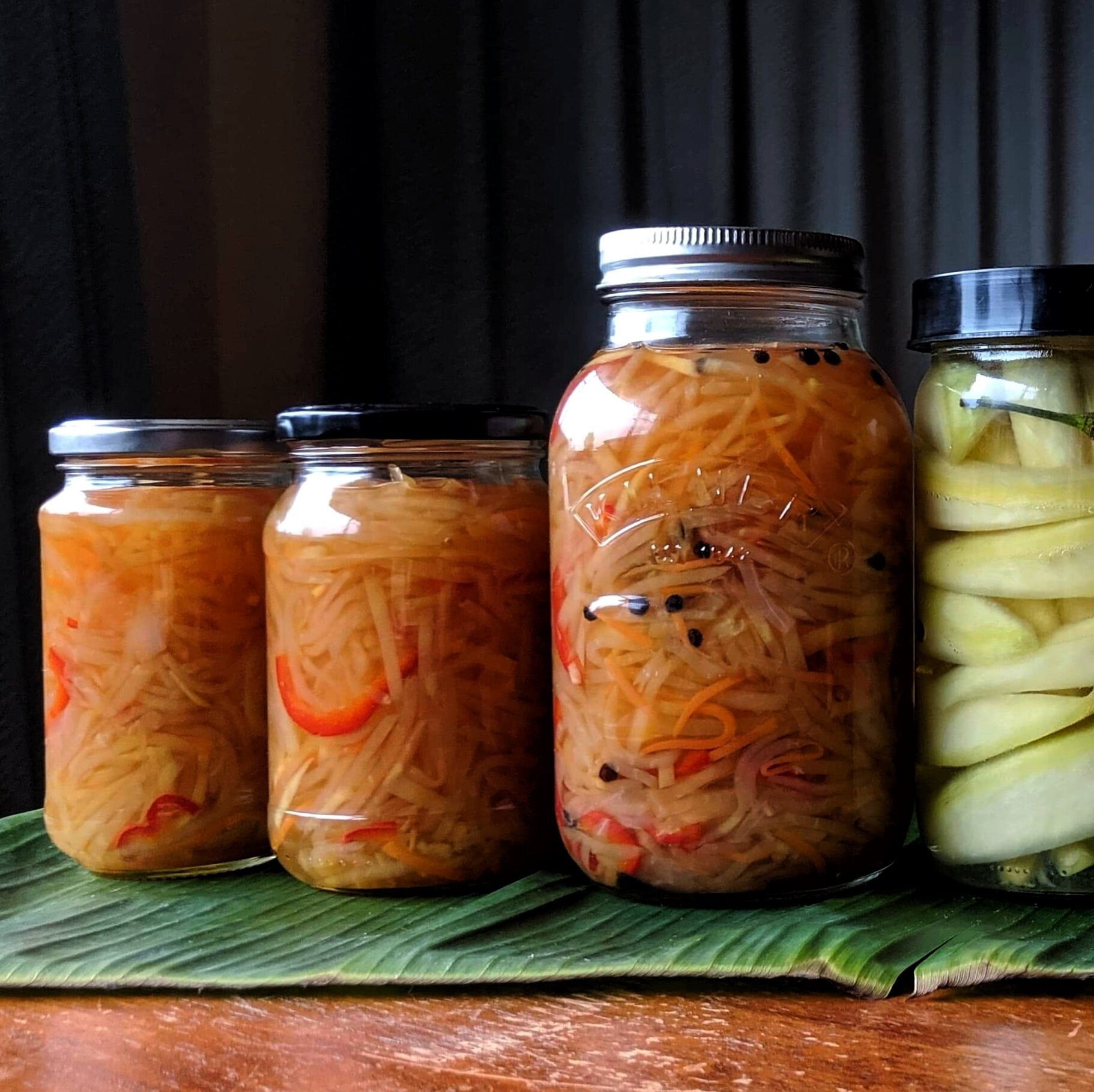Atchara (Pickled Green Papaya Relish)
Recipe created By Margaret Sevenjhazi
This Filipino condiment was presented at SAHOG @ Home
An Instagram Live series featuring our most loved Australian Filipino Chefs, Cooks and Food Lovers
Photo : Courtesy of Margaret Sevenjhazi
ZERO WASTE TIPS:
Ginger Skin: Add to your tea with lemon and honey!
Papaya Seeds:: You can eat these! Try one! They have a crunchy texture and a slightly peppery flavour and can be used a bit like pepper. Pop in a strainer and rinse. Rub with your
hands to remove residue and place them on a clean tea towel to air dry. Crush or grind to use as a seasoning. Alternatively you can dry them out and plant them.Drained Papaya Salting Liquid : It has a fantastic papaya pink hue and tastes like a salty atchara liquid. You can use it straight away like a light vinegar for dressings, brightening sauces
and if you put it in a sterilised jar or bottle and refrigerate it will ferment and slowly turn into a proper tangier vinegar.
Papaya Peel : Inedible peels can always be composted or added to the soil in your garden. Apparently you can rub the papaya peels on your face and neck like a sort of exfoliating face
mask, leave for 20 mins and rinse off. The papaya peels contain enzymes that help remove dead skin cells. NOTE: If you’re allergic to latex you’ll likely be allergic to papaya.
BOTTLING NOTE:
To curb the chance of bacteria spoiling your pickles and condiments quicker ensure all your equipment is thoroughly cleaned. Once all these are made we’ll store them in sterilised jars
to make sure they maintain freshness. To sterilise jars first clean jars with warm soapy and then you can either:
Boiling method : Put your jars and lids in a pot of cold water and boil for 10-15 mins then dry on cooling rack.
Oven method : Place jars upright into a cold oven on a cold tray (otherwise you’ll break your jar) then heat at 110 degrees for 10-15 mins. Boil lids in hot water for 5 mins then dry on a cooling rack.
For more zero waste and fermentation recipes you can follow Margaret on instagram at @_Bottomfeeder
Inspired by Yasmin Newman’s recipe from 7000 Islands: A Food Portrait of the Philippines - Basic atchara is a versatile, salty, sweet and tangy mix of pickled papaya and carrot, kind of like Vietnamese Do Chua (pickled daikon and carrot). This version includes daikon, pineapple juice and a healthy dose of ginger. If you like things hot add chilli instead of pepper. Traditionally nipa (palm vinegar) is used as it brings a wonderfully unique sour tang. Great with just about anything! BBQ and deep fried meats, sandwiches, rice bowls, eggs, tofu, lumpia shanghai (Filipino spring rolls) and roasted veg. Choose dark green, hard papayas for best results.
INGREDIENTS
1 green papaya, peeled, seeds removed (set aside) and quartered
1 small carrot, peeled
1/2 small daikon radish
1/2 small red capsicum, seeded and very thinly sliced
1/2 small red onion, very thinly sliced
2 tbsp fine salt, non iodised
750ml nipa (palm) or apple cider vinegar
130g dark brown sugar
130ml pineapple juice
10cm piece ginger, peeled, halved and cut into fine matchsticks
1 tbsp black peppercorns
METHOD
1. Cut the green papaya into quarters. Then use a mandolin with a julienne insert or a julienne peeler to slice the papaya, daikon and carrot into fine strips. Cut the carrot strips in half. Add the
papaya, daikon, carrot, capsicum, onion and salt, to a colander over a large bowl. Toss well and allow it to drain into the bowl. Set aside for 10-15 mins to allow the salt to extract excess liquid from the vegetables.
2. Put a large pot on high heat, adding the vinegar, sugar, pineapple juice and ginger, and bring to the boil. Stir often till the sugar dissolves. Turn off the heat.
3. Drain the liquid from the papaya and squeeze to extract excess liquid. Repeat the squeezing process until only a little liquid is coming out - extracting moisture will help encourage fermentation.
4. Add the papaya mixture to the pot of vinegar. Bring to the boil, then remove from the heat.
5. Use clean tongs to pack the papaya mixture into 2 large sterilised airtight jars and seal. Stand at room temperature in a dark spot overnight to allow fermentation to begin, then tighten lids and
refrigerate for a minimum of 5 days to allow flavours to develop. Unopened it will last up to 1 year. Once opened it should keep in the fridge for up to 3 months. Use your judgement if keeping it past this time - it won’t smell as appetising if it’s gone bad.

